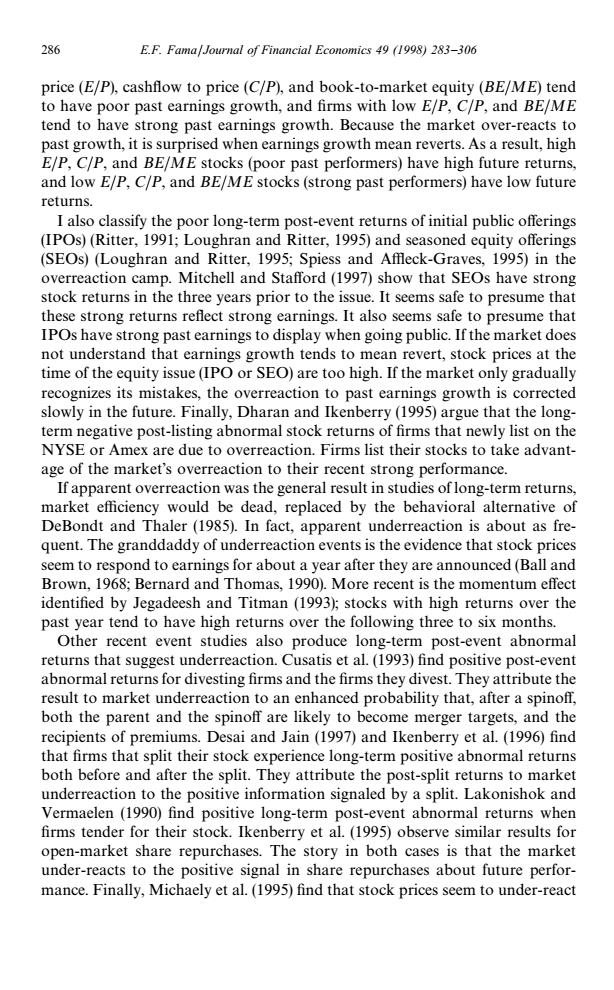正在加载图片...

286 E.F.FamafJournal of Financial Economics 49 (1998)283-306 price(E/P),cashflow to price(C/P),and book-to-market equity (BE/ME)tend to have poor past earnings growth,and firms with low E/P,C/P,and BE/ME tend to have strong past earnings growth.Because the market over-reacts to past growth,it is surprised when earnings growth mean reverts.As a result,high E/P,C/P,and BE/ME stocks(poor past performers)have high future returns, and low E/P,C/P,and BE/ME stocks(strong past performers)have low future returns. I also classify the poor long-term post-event returns of initial public offerings (IPOs)(Ritter,1991;Loughran and Ritter,1995)and seasoned equity offerings (SEOs)(Loughran and Ritter,1995;Spiess and Affleck-Graves,1995)in the overreaction camp.Mitchell and Stafford(1997)show that SEOs have strong stock returns in the three years prior to the issue.It seems safe to presume that these strong returns reflect strong earnings.It also seems safe to presume that IPOs have strong past earnings to display when going public.If the market does not understand that earnings growth tends to mean revert,stock prices at the time of the equity issue(IPO or SEO)are too high.If the market only gradually recognizes its mistakes,the overreaction to past earnings growth is corrected slowly in the future.Finally,Dharan and Ikenberry(1995)argue that the long- term negative post-listing abnormal stock returns of firms that newly list on the NYSE or Amex are due to overreaction.Firms list their stocks to take advant- age of the market's overreaction to their recent strong performance. If apparent overreaction was the general result in studies of long-term returns, market efficiency would be dead,replaced by the behavioral alternative of DeBondt and Thaler(1985).In fact,apparent underreaction is about as fre- quent.The granddaddy of underreaction events is the evidence that stock prices seem to respond to earnings for about a year after they are announced(Ball and Brown,1968;Bernard and Thomas,1990).More recent is the momentum effect identified by Jegadeesh and Titman(1993);stocks with high returns over the past year tend to have high returns over the following three to six months. Other recent event studies also produce long-term post-event abnormal returns that suggest underreaction.Cusatis et al.(1993)find positive post-event abnormal returns for divesting firms and the firms they divest.They attribute the result to market underreaction to an enhanced probability that,after a spinoff, both the parent and the spinoff are likely to become merger targets,and the recipients of premiums.Desai and Jain (1997)and Ikenberry et al.(1996)find that firms that split their stock experience long-term positive abnormal returns both before and after the split.They attribute the post-split returns to market underreaction to the positive information signaled by a split.Lakonishok and Vermaelen (1990)find positive long-term post-event abnormal returns when firms tender for their stock.Ikenberry et al.(1995)observe similar results for open-market share repurchases.The story in both cases is that the market under-reacts to the positive signal in share repurchases about future perfor- mance.Finally,Michaely et al.(1995)find that stock prices seem to under-reactprice (E/P), cashflow to price (C/P), and book-to-market equity (BE/ME) tend to have poor past earnings growth, and firms with low E/P, C/P, and BE/ME tend to have strong past earnings growth. Because the market over-reacts to past growth, it is surprised when earnings growth mean reverts. As a result, high E/P, C/P, and BE/ME stocks (poor past performers) have high future returns, and low E/P, C/P, and BE/ME stocks (strong past performers) have low future returns. I also classify the poor long-term post-event returns of initial public offerings (IPOs) (Ritter, 1991; Loughran and Ritter, 1995) and seasoned equity offerings (SEOs) (Loughran and Ritter, 1995; Spiess and Affleck-Graves, 1995) in the overreaction camp. Mitchell and Stafford (1997) show that SEOs have strong stock returns in the three years prior to the issue. It seems safe to presume that these strong returns reflect strong earnings. It also seems safe to presume that IPOs have strong past earnings to display when going public. If the market does not understand that earnings growth tends to mean revert, stock prices at the time of the equity issue (IPO or SEO) are too high. If the market only gradually recognizes its mistakes, the overreaction to past earnings growth is corrected slowly in the future. Finally, Dharan and Ikenberry (1995) argue that the longterm negative post-listing abnormal stock returns of firms that newly list on the NYSE or Amex are due to overreaction. Firms list their stocks to take advantage of the market’s overreaction to their recent strong performance. If apparent overreaction was the general result in studies of long-term returns, market efficiency would be dead, replaced by the behavioral alternative of DeBondt and Thaler (1985). In fact, apparent underreaction is about as frequent. The granddaddy of underreaction events is the evidence that stock prices seem to respond to earnings for about a year after they are announced (Ball and Brown, 1968; Bernard and Thomas, 1990). More recent is the momentum effect identified by Jegadeesh and Titman (1993); stocks with high returns over the past year tend to have high returns over the following three to six months. Other recent event studies also produce long-term post-event abnormal returns that suggest underreaction. Cusatis et al. (1993) find positive post-event abnormal returns for divesting firms and the firms they divest. They attribute the result to market underreaction to an enhanced probability that, after a spinoff, both the parent and the spinoff are likely to become merger targets, and the recipients of premiums. Desai and Jain (1997) and Ikenberry et al. (1996) find that firms that split their stock experience long-term positive abnormal returns both before and after the split. They attribute the post-split returns to market underreaction to the positive information signaled by a split. Lakonishok and Vermaelen (1990) find positive long-term post-event abnormal returns when firms tender for their stock. Ikenberry et al. (1995) observe similar results for open-market share repurchases. The story in both cases is that the market under-reacts to the positive signal in share repurchases about future performance. Finally, Michaely et al. (1995) find that stock prices seem to under-react 286 E.F. Fama/Journal of Financial Economics 49 (1998) 283—306